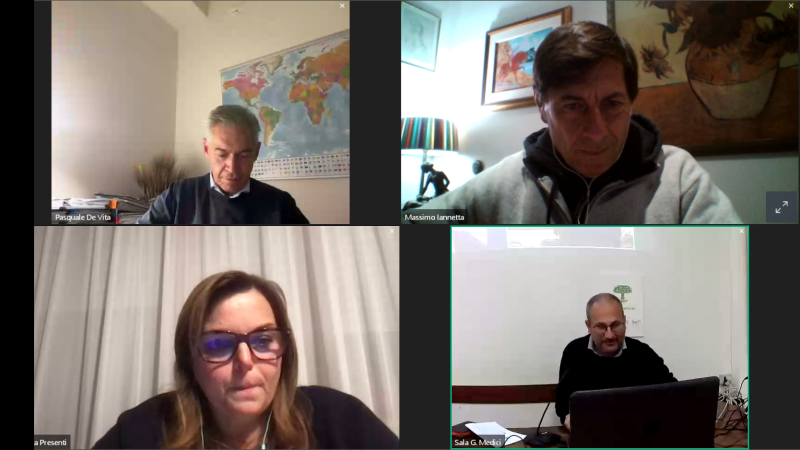FAO: Saving Mediterranean olives from a destructive disease

In 2013, Italian researchers made a troubling discovery: one of the world’s most destructive plant diseases, normally found in the Americas, had made its way to Italy’s olive trees. With no known cure, the pathogen has already affected more than 10 million trees in Italy’s south-eastern tip. If not properly contained, it threatens to spread across the entire Mediterranean basin. The Italian government contracted national research institutions and the International Center for Advanced Mediterranean Agronomic Studies (CIHEAM) to survey and contain Xylella fastidiosa. However, other Mediterranean countries are at great risk if the disease spreads further.
Not only olive trees but also more than 500 other plant species are hosts for the various strains of the bacterium. If not prevented, smallholder farmers in the NENA region could have their livelihoods devastated and national economies destabilized by the potential spread into the region. Because of these risks, FAO has launched a project to support NENA countries in their efforts to prevent the introduction and spread of this disease.
Xylella fastidiosa: a spreading threat
Xylella fastidiosa has long caused problems in the Americas—where the cost of its damage is estimated at hundreds of millions of dollars each year. Beyond olive trees, different strains of Xylella fastidiosa can also harm grapes, stone fruits, citrus and ornamental plants. The disease is difficult to quarantine because the bacterium is transmitted by insects and infected trees take a long time to display symptoms, as the incubation period for Xylella fastidiosa can last from seven months to more than a year.
If an insect sucks sap from an infected tree, it can carry bacteria to other trees. However, the disease also spreads through the transport of infected plants, especially by ornamental plants which may contain the bacteria without showing symptoms.
Symptoms of a Xylella fastidiosa infection include weakened branches, dried leaves and hardened, shrunken fruits. Infected trees effectively experience an internal drought: multiplying bacteria latch onto the xylem tubes that transport water and nutrients, choking off the tree’s extremities.
Innovative tools
In order to mitigate the potential threat of Xylella fastidiosa to countries across the Mediterranean, FAO is supporting preventative efforts in Algeria, Egypt, Lebanon, Libya, Morocco and Tunisia. By implementing modern technologies for detection, FAO is helping countries test imported planting materials – the main pathway for the introduction of the bacteria from long distances – in a more accurate, economic and simplified way.
An important component of the project was the introduction of the innovative Loop Mediated Isothermal Amplification (LAMP) device, which can test plants and insects in real-time to detect any molecules associated with the disease. Portable LAMP devices are used with tablets as the interface to the device, running tests and receiving results. These devices enable farmers and scientists to immediately identify and report on Xylella fastidiosa in the field, without waiting to hear from a lab.
Spreading the word
Media campaigns and press conferences have helped spread information about Xylella fastidiosa, with effective outreach over social media, radio and TV in Egypt and Libya. In addition, regional awareness-raising days were organized in the NENA countries, targeting technicians, farmers, nursery workers, students and customs inspectors to be able to detect and address plants infected with the bacteria.
To continue providing vital information, a number of communication channels were set up (including toll-free telephone hotlines, e-mail, WhatsApp and Facebook) for stakeholders to share information and address questions relating to the management of the disease.
FAO has also organized a series of training sessions for stakeholders on surveillance, diagnosis and management practices relating to Xylella fastidiosa. These workshops assisted each country in organizing national and regional awareness days, as well as training sessions for diagnosing and monitoring Xylella fastidiosa. In turn, these events reached additional 3 858 participants (of which 942 were women), including specialists, researchers and farmers.
Prevention is the only way
Despite countermeasures being taken, the disease continues to kill olive trees in Italy and has spread to Spain and France. So far, it has not been reported in North Africa and the Near East.
To prevent the disease from making further inroads, FAO is assisting at-risk countries in updating their phytosanitary legislation and strengthening phytosanitary measures at ports of entry to prevent its introduction through trade. In the worse case scenario, FAO is also helping countries to develop contingency plans if any detection of the disease occurs.
By establishing coordinated regional surveillance systems, organizing international communication about risks and improving capacities to detect and respond to the disease, FAO hopes to prevent its introduction into new territories.
As part of this prevention effort, FAO has developed a dedicated mobile application (XylAppNENA) and database for each country to collect field data. Despite the difficulties in managing the disease, preventative measures and early detection greatly reduce the risk and spread of infection. Containing Xylella fastidiosa means greater stability and yields for farmers across the Mediterranean—and is good news for olive-lovers worldwide.





